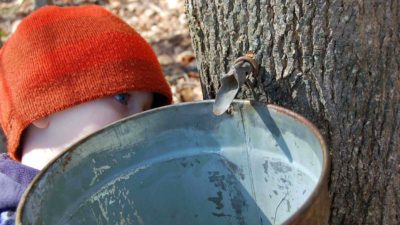Maple Tree Sizes for Tapping
We recommend that you tap maple trees at least ten inches in diameter. The easiest way to check the diameter is to cut a ribbon at a length of 32”.
If the circumference of the tree is greater than the cut ribbon, you’re good to tap.
How Many Taps Per Maple Tree
We highly recommend only one tap per maple tree.
There’s a lot of discussion on the Internet about adding multiple taps for very large trees. While it can be done, the impact to the tree with staining columns, non-conductive wood, and general tree health could become an issue in the future.
Tap, Tap, Thud
Many people use spiles to tap their maple trees. Spiles are metal spouts that are inserted into the drilled hole. Buckets are usually hung from a hook on the spile.
Use a hammer to gently tap the spile or spout into the tap hole. Remember this idiom: “tap tap thud”.
Tap your spout into the tree while listening to the sound of the tapping. When there is a change in the sound of the tapping of your spout, you’re done. The tap only sites in the hole about one-half inch.
Watch and listen to the sound of the hammer in the video below.
Track Tap Holes
Tapping in the same area multiple years in a row was the single biggest mistake I made when starting to make maple syrup.
Keep track of where you tap on your maple trees or you could lose up to 75% of the sap potential of the tree each year due to staining columns and nonconductive wood.
The area directly above and below a tap hole becomes nonconductive wood when the tree heals the tap hole. Nonconductive wood does not allow for the collection of water or the flow of sap.
Tapping into nonconductive wood yields very low amounts of maple sap.
Limiting tap holes to one per tree helps reduce the amount of nonconductive wood created each year.
Consider an imaginary two-inch-thick plane through the tree (this would look like a 2” slice of the tree). Then divide that into quarters. Each year tap into a different quarter. Following this protocol, it would take you five years to return to the quarter of the tree where you made your first tap hole.
Each year healthy trees add radial growth. If a healthy tree ads radial growth of ¼ inch per year, there would be one inch of fresh conductive wood covering the tap hole from four years prior.
Footnotes:
- Mark Isselhardt, Maple Specialist, Univ of Vermont Extension. OSAF Annual Meeting 20210310. https://youtu.be/Jp8YKnFXnAM



